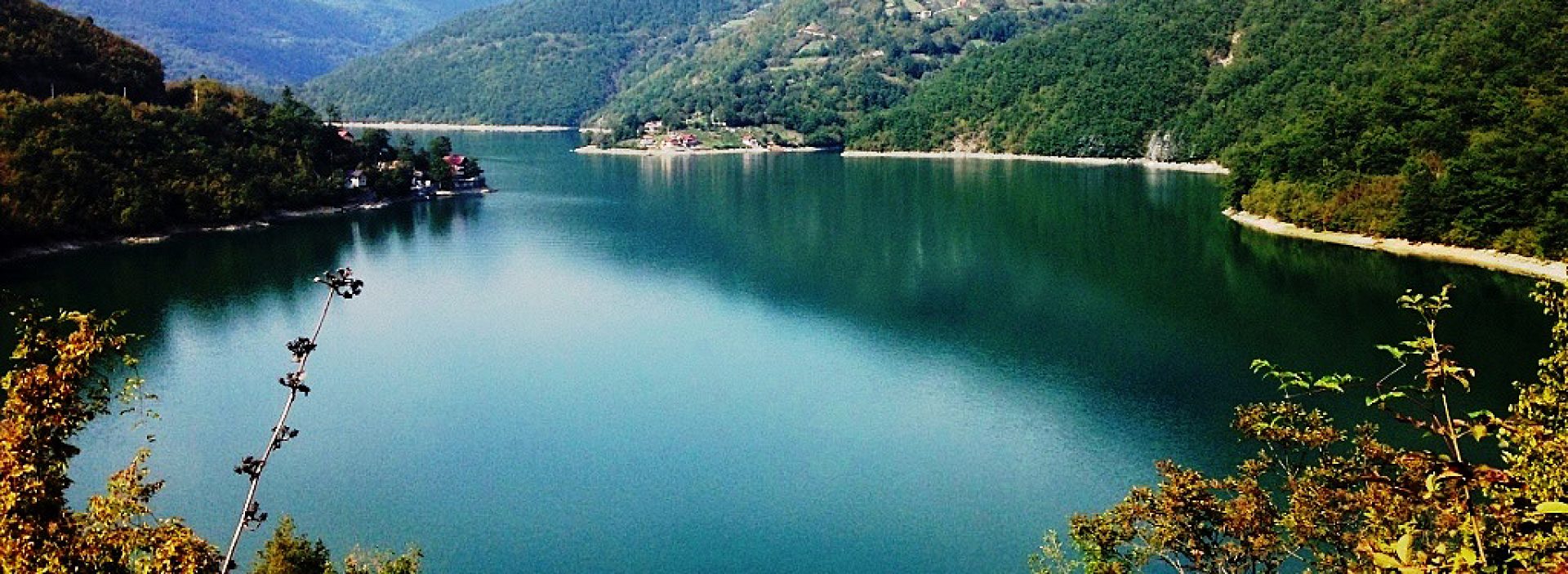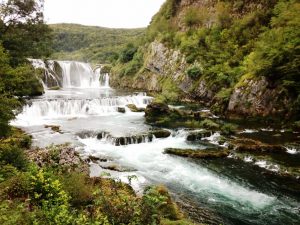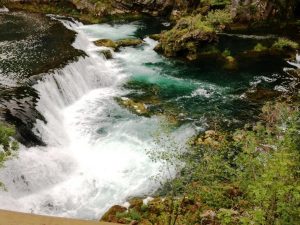During your stay at our center you can fulfil your spare time by visiting the natural beauties of National Park UNA as well as the tourist attractions of Bihac city with our licensed tour guides.
National Park UNA is one of three national parks in Bosnia and Herzegovina and first in Federation B&H. It was established in 2008. It covers the area of the upper canyon of river Una upstream from Lohovo and lower canyon of river Unac all the way to the small river Krka in the west.
Along the valley of river Una, in the most part of National Park Una, you can find cultural monuments, fortresses, towers and towns which present the additional value to the National Park. This area was undoubtedly settled since the ancient times until today. Evidence to this could be found in numerous archeological sites, remains of many fortresses as well as still existing medieval fortresses.

RIVER UNA
River Una got its name from ancient Romans, who, when they saw its lively colors and heard the gurgle of its waterfalls shouted: “UNA”, which in Latin means the one, the only one, the unique one. The first big waterfall is in Martinbrod, a small town some 50 kilometers away from Bihać. This is the spot where Una takes the viewer’s breath away as the travertine created numerous canals, rapids, small islands and few waterfalls close to one another, the biggest one of which is 20 meters high and it is a magnificent image a man can enjoy for hours.
Traditionally, the international Una Regatta takes place on this river every year. Bihać and Una are famous across Europe for white water rafting, so it attracts large number of people from all parts of the world.
 FETHIJA MOSQUE
FETHIJA MOSQUE
When Ottomans came to this area in 1592 and conquered the last fortification in Una Basin – Bihac, much had changed and altered within the fortification walls of the town. First thing that new authorities did was reconstruction of the existing Churches into Mosques. By the order of the commander of Ottoman Army and long-term commander of Bihac, Hasan-Pasha-Predojevic, St. Antun Church was transferred into the main Mosque in town – Fethija (conquered). Old records show that St. Antun Church was built at the end of 13th and beginning of 14th Century and that it was tastefully built sacral building in gothic style with high roof, pointy rooms made of decoration stone and octagon bell tower. Next to the Church stood a Dominican Monastery which was mentioned in the charter of Croatian feudal lords back in year 1266. Ottoman builders did however leave some of the old outlines of the Church. Few windows on south and north side of the Church were sealed up and new windows opened and gothic rosette above the big entrance door was preserved. At the very base of the minaret there are still two undamaged inscriptions in Arabic that talk about construction of this religious monument. For four centuries Bihac’s Mosque Fethija has been defying time. It survived numerous bombings of the city and sufferings of people from “Krajina” but it remained monolith, beautiful and worth admiring. Fethija Mosque is one of the most preserved sacral monuments in Bosnia and Herzegovina.
 BIHAC‘S MAUSOLEUM
BIHAC‘S MAUSOLEUM
There are several myths about the construction of the Mausoleum. One says that two pashas got killed defending the fortified Bihac from the powerful army of Franc Joseph. They were buried to rest in piece across from the Captain’s tower. The wife of one of them claimed to have seen a green light coming out of the graves and according to the religion it meant that pashas had consecrated. Shortly after that faithful believers raised a wooden mausoleum right above the graves and built two headstones inside. For a long period of time this monument was guarded by the sentry. We can say with certainty that the Mausoleum comes from the period of Ottoman rule of B&H. When Austro – Hungarians came to this area they moved the Mausoleum for few meters and rebuilt it in “Bihacit” stone and that shape and form has remained until today. This purely sacral monument was damaged during the last war in B&H but it was repaired and today it presents precious value of Muslims’ spiritual culture of this area. There is no knowledge about who those two pashas were but even without those details Bihac Mausoleum attracts the attention of all the visitors who come here to see the city and meet its people. Together with the Captain’s tower and the Catholic Church tower, Mausoleum makes the historical core of Bihac and gives the city a distinctive mark.
 SAINT ANTON’S CHURCH
SAINT ANTON’S CHURCH
Saint Anton’s Church was built at the end of the 19th Century and finished in 1894. It was built on the location of one of the destroyed medieval Bihac Churches. Catholic Church in Bihac belongs to those sacral buildings that can be seen all over NW part of Croatia. The constructors of St. Anton’s Church, before all, made sure that this building has got emphasized space conception but at the same time not neglecting the use of decorative elements. The Church itself was more than impressive for its time. The Church occupied around 900 square meters of space. With its tall rectangle bell tower, together with Fethija Mosque and Captain’s Tower, it dominated over the town’s urban core. The Church changed its previous appearance during the WWII. In 1941, the authorities decided to demolish the Orthodox Church in Bihac and to use the material to expand the Catholic Church. Another storey was added to the bell tower and Church itself was extended into the shape of a cross. After the reconstruction it became one of three biggest Churches in Bosnia whose length was 58 meters. In 1944 Allied aviation forces bombed the enemy positions within the city on which occasion the Church also got destroyed. Nowadays the only part left to withstand the time is the rectangle bell tower, a reminder of all the terrors of war.
 CAPTAIN’S TOWER
CAPTAIN’S TOWER
Although it is one of the oldest historical landmarks of Bihac, its date of birth still hasn’t been determined. Since its constructors hadn’t left any information about this building for future generations, historians were able to determine approximate time period it comes from: late Croatian and early Ottoman. As many buildings in Bihac, Captain’s Tower has its own little history. According to the theory by H. Strauss in his book “Towers of Bihać”, Captain’s tower was built in 1205. and it was one of the four towers, three of which were destroyed in 1201 – 1202. According to the legend that contains bits of historical foundation, Captain’s Tower and fortified Bihac saved Hungarian King Bella the Fourth from Tartar cavalrymen, who had chased him to the walls of Bihac fortress. As a token of his Royal appreciation, King Bella the Fourth proclaimed Bihac a free town. When Austro – Hungarians came here they turned the Captain’s Tower into a county prison. For long period of time, ever after Bihac grew out of its walls and became an urban center, Captain’s Tower was used only as prison until it was given to the Regional Museum in 1959. Building was completely adopted and turned into Museum, where you can see many artifacts from Illyrian and Roman period.






